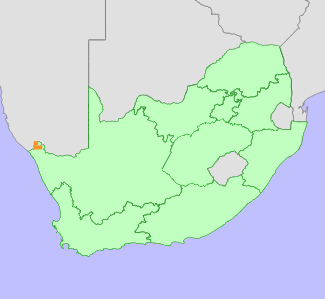|
Scientific Name | Acanthopsis ludoviciana H.M.Steyn |
Higher Classification | Dicotyledons |
Family | ACANTHACEAE |
Synonyms | Acanthopsis hoffmannseggiana in the sense of Williamson (2000), not of (Nees) C.B.Clarke (misapplied name) |
National Status |
Status and Criteria | Endangered B1ab(iii,v)+2ab(iii,v) |
Assessment Date | 2022/10/28 |
Assessor(s) | L. von Staden, H.M. Steyn & P.C.V. Van Wyk |
Justification | A localized species (EOO 206 km²), known from five locations. The subpopulation in Helskloof is in decline due to drought and approximately 50% of the plants have died. There is a continued decline in habitat quality due to severe overgrazing, and the population continues to decline due to ongoing drought mortality. It therefore qualifies for listing as Endangered under criterion B. |
Distribution |
Endemism | South African endemic |
Provincial distribution | Northern Cape |
Range | This species is endemic to the Richtersveld, where it occurs from Kodaspiek to Vandersterrberg. |
Habitat and Ecology |
Major system | Terrestrial |
Major habitats | Central Richtersveld Mountain Shrubland, Western Gariep Hills Desert, Richtersveld Sheet Wash Desert |
Description | It occurs in sandy, well-drained soils, on flats as well as wedged among rocks on steep slopes. |
Threats |
| Around Numees, Helskloof and Paradyskloof, severe overgrazing is causing ongoing, severe habitat degradation. Here the species survives on steep rocky ridges, where trampling is not causing a severe loss and erosion of soil, as well as hidden among spiny Aloe pearsonii. This species appears to not be grazed at present, but livestock has been observed to start grazing on apparently unpalatable species when all other grazing species have been depleted (P. van Wyk, pers. obs.), and should overstocking continue, this species may be impacted in the future. On higher-lying, more remote areas such as Kodaspiek and the central Vandersterrberg, grazing is at present only occasional, but pressure may increase as grazing on lower slopes and more accessible areas continues to be depleted. Due to the severe drought (2016-2022), the subpopulation in Helskloof is in decline and approximately 50% of the plants have died (P. van Wyk). |
Population |
This species has a localized distribution, but is locally very common. The population is declining due to drought.
|
Population trend | Decreasing |
Assessment History |
Taxon assessed |
Status and Criteria |
Citation/Red List version | | Acanthopsis ludoviciana H.M.Steyn | VU D2 | 2017.1 | | Acanthopsis sp. (Koekemoer 4370 PRE) | VU D2 | 2015.1 | |
Bibliography |
Steyn, H.M. and Van Wyk, A.E. 2015. Taxonomic notes on the Acanthopsis disperma-hoffmannseggiana complex (Acanthaceae, tribe Acantheae), with an interim key to members of the genus. Phytotaxa 219(1):1-26.
Williamson, G. 2000. Richtersveld, the enchanted wilderness. Umdaus Press, Pretoria.
|
Citation |
| von Staden, L., Steyn, H.M. & Van Wyk, P.C.V. 2022. Acanthopsis ludoviciana H.M.Steyn. National Assessment: Red List of South African Plants version 2024.1. Accessed on 2025/11/02 |
 Comment on this assessment
Comment on this assessment

